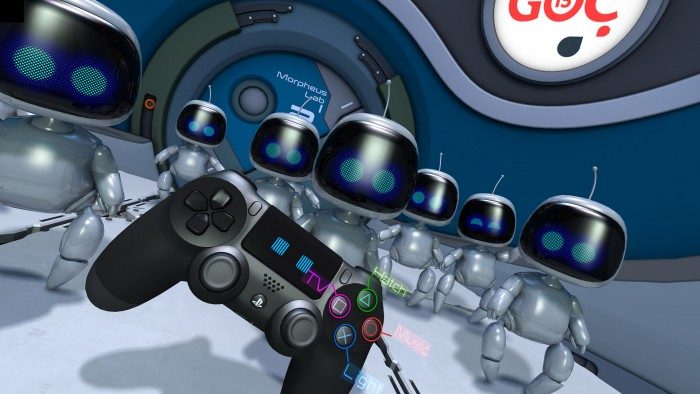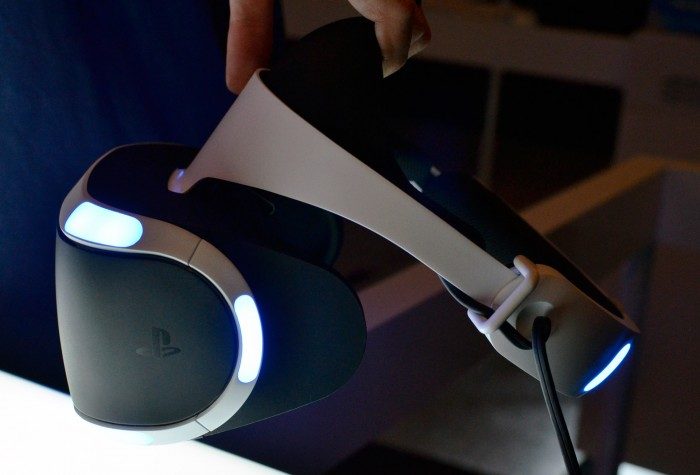With the reveal of Sony’s 2015 Morpheus prototype, the company surprised the VR space with the announcement that the headset would support a 120Hz refresh rate, significantly higher than the 90Hz of the competition. We went hands-on with the company’s first native 120Hz demo, Magic Controller, along with Bedroom Robots from the same studio.
The announcement that Morpheus would run at 120Hz (meaning 120 frames shown to the user, per second) was a surprise because on the one hand, it means extremely smooth imagery and low latency, but on the other hand, it’s a daunting challenge to render high quality visuals at 120 FPS to match the screen’s 120Hz refresh rate.
Not every game will run natively at 120Hz. Developers who want to push graphical fidelity over blistering performance will have the option to render at 60 FPS and use the ‘Asynchronous Reprojection’ technique to output at 120 FPS. Asynchronous Reprojection is similar to Oculus’ Timewarp—reading the latest sensor data right before rendering, and making a slight adjustment to the viewpoint before ‘scan out’, where the display’s pixels light up in accordance with the rendered frame.
The ‘Asynchronous’ part refers to using this technique in a separate thread to create new frames with new sensor data from the latest frame completed by the rendering thread. Oculus has been using Asynchronous Timewarp on Gear VR, but hasn’t yet implemented it on PC.
Oculus’ Michael Antonov has a technical analysis of Asynchronous Timewarp which will familiarize you with the technique if you’d like to know more.
Reprojection isn’t a magic bullet though. While it can work effectively for distant objects, near field imagery can reveal rendering errors if the player is moving their head too quickly. Sony’s Chris Norden said at GDC 2015 that “if you have a gun waving around in your face you’re going to notice some artifacts.” Oculus’ Antonov agrees saying that these techniques have “limitations that developers should be aware of.”
Norden also noted that implementing Asynchronous Reprojection may be a challenge for developers. “If your engine isn’t super flexible, and multi-threaded, you might have some trouble with this.”
Magic Controller
One new demo, Magic Controller, shown at the 2015 Morpheus prototype reveal, was indeed running natively at 120Hz and was responsible for one of the most clear and sustained moments of Presence that I’ve felt yet. The demo was created by Sony Worldwide Studios, Japan.
See Also: HTC Vive and SteamVR Hands-on – A Stage of Constant Presence
Magic Controller put me into the ‘Morpheus Lab’, a circular chamber where I was standing in front of an empty table. Looking down at the DualShock 4 controller in my hands revealed an identical virtual version that was tracked in space just like the PlayStation Move controllers. As I pressed buttons and tilted the sticks on the real controller, the input was perfectly mirrored, though I would soon find out that the virtual controller could to much more than the real one.
I could hear clamboring sounds and feel vibrations coming from the controller; where the trackpad would normally be was a pair of blue robot eyes. I clicked on the trackpad and the eyes winced as I heard some giggly robotic chatter. Tapping the triangle button caused the trackpad to open like a hatch, and out popped the Bots onto the table. Anyone who has tried Sony’s AR showcase The Playroom (2013) on PS4 will be familiar with these joyful critters.
The Bots are energetic and noisy, jumping and jostling for attention and reactively moving their heads to follow me as I leaned about in my chair.
At that point I saw some instructions pop-up around the buttons on the controller. As I pressed the circle button, I saw a MiniDisc tray open from the top of the controller and then slide back inside. With some vibrations, the bottom of the controller’s handle’s transformed into speakers and began bumping beats like a boom box, to which the Bots happily danced. The music coming out of the controller was positionally placed; as I moved it around my head I could hear the music as though it was coming out of the virtual controller itself.
Another button on the controller shut off the lights in the chamber and turned the controller into a flashlight. This is where a significant moment of Presence struck me. As I shined the light across the Bots and around the room, the scene felt incredibly real. There was something about the simple but seemingly accurate reflections on the shiny little Bots that brought me into that space and made me not want to leave.
This moment further underscores my long-held belief that accurate lighting models are much more important to apparent graphical realism than ultra high-resolution textures. One needs only to see how well a screenshot from 2007’s Halo 3 has stood the test of time to appreciate this. Developers looking to hit 120Hz for Morpheus will be smart to experiment with art direction that makes effective use of lighting instead of relying so much on textures and polygons.
Continue Reading on Page 2, Bedroom Robots
Page: 1 2



